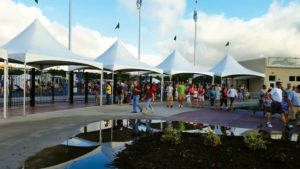Tent rental companies share the unique considerations they give to regional festivals.
By Jake Kulju
Like peanut butter and jelly and Simon and Garfunkel, festivals and tents are just better together. However, every classic combination has its variations. Tent rental companies across the continent face unique regional challenges and considerations. From climate to codes, regional tent installers need to be ready for anything that comes their way.
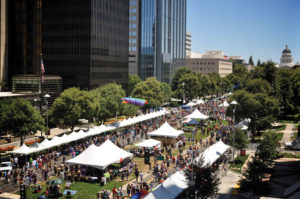
Fighting Fire
Fire safety is a concern everywhere, but especially in the arid west coast region of the United States. Donny Vasquez, vice president of marketing and special projects for Made in the Shade Tent Rentals Inc., West Sacramento, Calif., has to be on top of regional fire safety codes. “When we work on fair and festival setups, we are required to ensure that there is a 20-foot fire lane for emergency vehicular access,” he says. “[Most of our returning customers] are aware of this requirement. Since the festival business is booming in the Sacramento region, our customers rely on us, the tent company, to know the [fire safety] requirements. Luckily, we have great relationships with local fire marshals and fire districts, so
getting the correct information is sometimes just a phone call away.”
In South Carolina, Jason Robbins, general manager of Snyder Rental, says there is a list of “usual suspects” he has to be prepared for to meet local codes. “Egress, capacity [requirements], flame certificates, [fire] extinguishers, battery backups, flood and exit lights are the main concerns,” he says.
Pat Kane, co-owner of Lefty’s Tent and Party Rental of Bovey, Minn., is subject to fewer codes and inspections in the rural Upper Midwest. “We usually have an electrical inspector that comes out, but rarely an actual fire marshal,” Kane says. “The inspector comes out and makes sure that everything we are providing is grounded and has its own breaker. For the Bayfront Blues Festival [in Duluth, Minn.], we don’t have any dealings with any marshals at all. The committee that organized the event may, but we have had no conversation with
a fire marshal or inspector.”
That hasn’t stopped Kane from following best practices, however. “We go through the same format for every festival we set up,” he says. “Every one of our tents is wind rated, weighted and staked the appropriate way. Even though we don’t deal as much with fire codes and marshals in our market compared to some other markets, we still set up with safety in mind.”
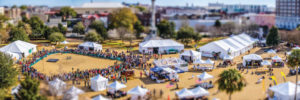
A Mighty Wind
Unpredictable weather is one of the main reasons festivals need tents in the first place. In the windy southwestern region of the U.S., proper ballasting is a must for festival tents. Dan Kasid, co-owner of All Events Tent & Party Rentals of Longmont, Colo., avoids installing tents in certain parts of the state known for heavy wind gusts. “There are areas we don’t install in because we know there’s no way to salvage our tents once the wind picks up,” Kasid says.
Heavy winds from the mountains are a big factor in Kasid’s ballasting calculations for his festival tents. “We have a baseline we follow, and then if we know we will be dealing with wind, we augment our calculations,” he says. “We will occasionally use IFAI TRD’s ballasting tool.”
Near the Gulf Coast, Bob Alexander, owner of Alexander Tent Rentals Inc. in Houston, Texas, also prepares his festival tents for unexpected winds. “We have a lot of exposure to freak storms that come in off the Gulf and we have a good bit of wind in our part of Texas in general,” he says. “We don’t like heavy wind and heavy rain, and we really don’t like the two at the same time. I am always focused on anchoring our tents securely to prevent any problems before they start.”
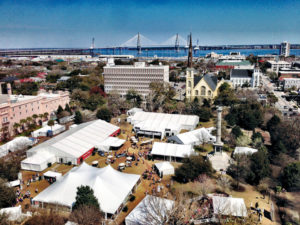
The blustery winter weather of Alberta, Canada, doesn’t stop festivals unless temperatures get really cold. Lars Erickson, director of business development for Special Event Rentals of Edmonton, Alberta, Canada, says his crews will set up tents in temperatures as low as -15 degrees Celsius. “We have had our tents engineered for snow loads and pitched just right,” Erickson says. “We provide tents for the Silver Skate Festival, which highlights snow shoeing, marathon skating and snow sculpture competitions. We also provide tents for downtown Edmonton’s outdoor Winter Shake-up! Festival and Market.” Erickson says a crew member is always on standby during inclement weather in case snow or freezing rain begins to build up on a tent.
In Lieu of Water Weights
Stability is always on a tent installer’s mind. Many crews rely on water weights in 55-gallon drums to provide stability in areas where staking is not permitted or is not feasible. Long spans of drought and increased utility costs across the country may be changing that practice. “California has been in drought for almost a full year now,” Vasquez says. “Last year we decided that we would no longer offer water barrel weights when staking was not permitted. In lieu of water weights, we now use 350- to 700-pound cement blocks.”
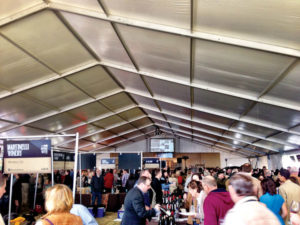
The transition increased Vasquez’s operating costs because of the extra transportation and loading/unloading requirements, but Vasquez thinks that in the long run it is the right choice. “Most of our customers understood the situation,” he explains. “Some customers had to be eased into the added costs as their budgets did not account for this increase. In the end, most of our customers understood the reason why we switched. Not only is cement safer than water, requirements for the anchoring of tent structures far exceed what any water barrel weights can provide. The added bonus is we are conserving water.”
Robbins has also converted his water weights to concrete ballast. “We steered away from water barrels specifically because of the dilemmas of locating a willing water supplier and to avoid dumping hundreds of gallons of water on the client’s property,” he says.
Even in water-rich Minnesota, Kane notices a trend away from water weight. “Water is rapidly working its way out of our industry right now,” he says. “I’ve never used water weight because it is too easy for the water to slide and for the tent to slip or blow away.”
Safety Zones
First aid and security are omnipresent at most festivals. The facilities, people and equipment often require tent solutions before and after the scheduled festival takes place.
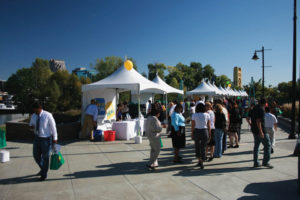
“Most events have a first-aid
station,” Vasquez says, “and almost all major events in California are required to be fenced in. Most
festival events must also submit
an emergency plan to the city and fire departments.”
Robbins also anticipates security needs at the festivals he tents. “We always have 24-hour security for our downtown festivals,” he says. “Typically security begins as soon as the lighting equipment is installed and continues through the strike of that equipment. This can be up to a week prior to the event and usually lasts for two nights after the last day of the festival.”
Alexander faces the strict regulations and permit requirements in his region head on. “If a tent is 1,200 square feet or larger, we have to get special permitting, which creates all kinds of restrictions about capacity, exit routes, noise restrictions, etc.,” he says. “The city of Houston has inspectors whose primary job is to regulate [tents of this size] and they are required to attend tented events and charge per hour for their time.”
Special Event Rentals’ Erickson says festivals that provide food require the ongoing presence of a health inspector. “If a client is serving food, the health inspector has to give approval before food preparation begins and monitor the food throughout the festival.”
Kane points out that although the area he operates in is not subject to strict regulations, he knows it is only a matter of time until they become the norm. “I know that it’s coming,” he says, “so we already monitor everything we do and how we go about doing it to make sure we are prepared.”
Regional differences in ballasting practices, fire regulations and wind tolerances aside, Alexander gives voice to one thing in the festival business that underlines the importance of tent rental companies. “You just have to sit down and talk to people and find out what they are doing and what the purpose of their event is,” he says. “Once you get a few basic questions answered, you can help guide them in the right direction. You almost become an honorary event coordinator.”
Jake Kulju is a freelance writer based in Minneapolis, Minn.
 TEXTILES.ORG
TEXTILES.ORG



